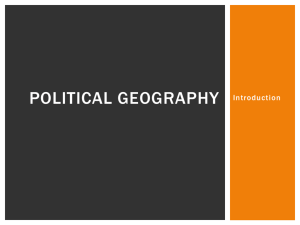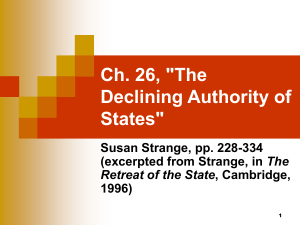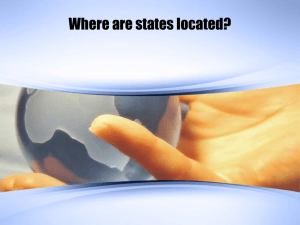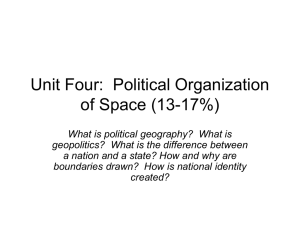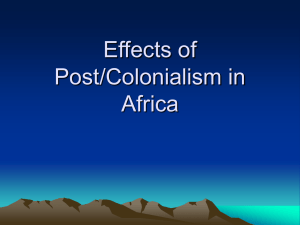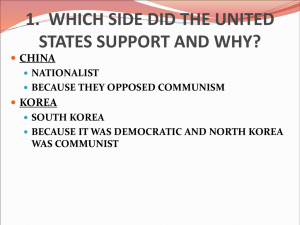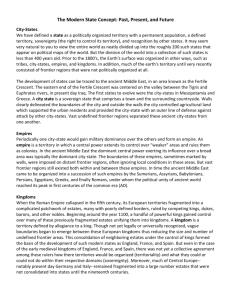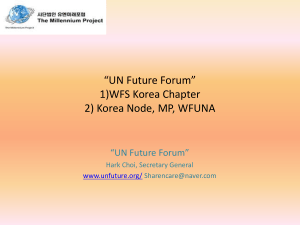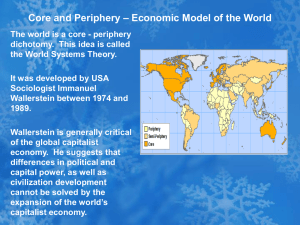File
advertisement
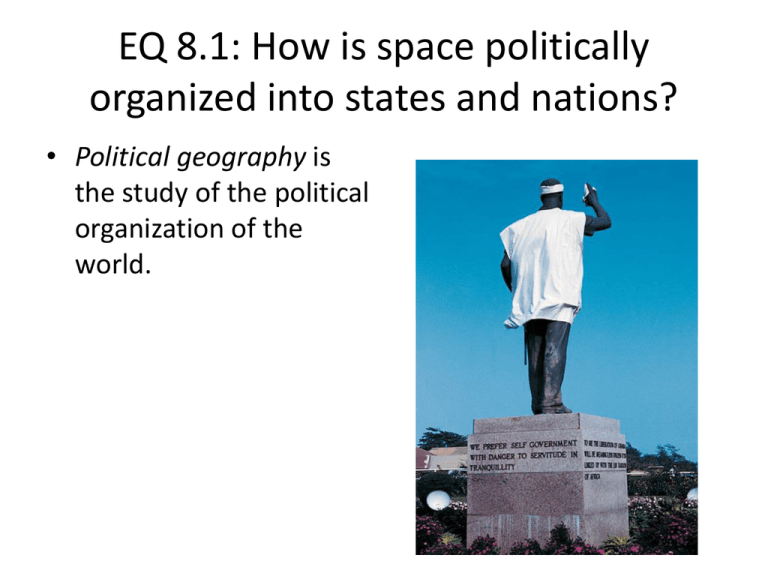
EQ 8.1: How is space politically organized into states and nations? • Political geography is the study of the political organization of the world. • Three major terms: – State – Territory – Nation STATE • STATE: – – – – Permanent pop Defined territory Organized gov’t Recognized by other states • Can be called a “country” United States of America… • …are not really 50 “states” • are 50 regional gov’ts ALL part of ONE big state How many states are there? • 1940=50 (why so few??) • 2014=206 states recognized by UN – In terms of sovereignty, 190 of those are undisputed What is Sovereignty? • Sovereignty= having the last and ultimate say over a territory politically and militarily (legal claim). – If a state is sovereign, they have control over themselves. • They also have the right to protect themselves from outside invaders: territorial integrity. Potential Problems • Political organizations are trying to accommodate various groups of people of different backgrounds (religious, language, identity). • Territoriality: according to Robert Sack is “an attempt by an individual or group to affect or control…a geographic area.” Problem: Antarctica • Antarctica= NOT SOVEREIGN – Largest landmass NOT part of a state – Argentina, Australia, Chile, France, New Zealand, Norway, and the U.K. claim portions of Antarctica – The U.S. and Russia do not recognize any of those claims – Antarctic Treaty: signed by states whose scientists are active in and around Antarctica Problem: Korea • After WWII - two occupation zones but one country • 1950 – Northern Korea (communist) invaded Southern Korea (capitalist) – 38th parallel established as division, creating separate countries • Both have been admitted to the U.N. as separate countries • Desire to reconcile, BUT gov’t and nukes keep apart North and South Korea Nighttime satellite image shows the contrasting amounts of electric lighting in South Korea compared to North Korea. China vs Taiwan • Chinese Civil War in the 1940's – Nationalists lose, flee to Taiwan in 1949 – Communists run China • According to China, Taiwan is not a separate, sovereign state (“One China Policy) BUT – China=People’s Republic of China – Taiwan=Republic of China – In eyes of UN…unclear… • Most other countries recognize Taiwan as separate – Competes in Olympics as “Chinese Taipei” Size of States • Some states are enormous: Russia (6.6M sqM) • Some are big: China, Canada, U.S., Brazil & Australia – China & Canada~3.6M sqM, U.S.~3.5M, Brazil~3.3M • Dozens of microstates: tiny land area – Many islands – Monaco=smallest (.6sqM) History: Development of States • Ancient States: Mesopotamia – City-states: a sovereign state that comprises a town and the surrounding countryside – Walls define the city, and the city would control the agricultural land surrounding it Development: Early Euro States • Estab by Roman Empire • Estates owned by competing kings, dukes, barons, and other nobles • 1100: a few rulers of large estates gained power over large numbers of estates. This formed the basis for the development of England, France, and Spain The Modern State Idea • The idea of a state that is tied to a particular territory with defined boundaries (Peace of Westphalia, 1648) • The idea came out of European influence and diffused through: – mercantilism – colonialism Colonialism • Colony: a territory that is legally tied to a sovereign state rather than being completely independent • Colonialism: the effort by one country to establish settlements and to impose political, economic, and cultural principles • 3 motives for colonialism: God, gold, and glory • Much of Africa/Asia held as colonies 1800send of WWII Colonial Possessions, 2006 Fig. 8-5: Most of the remaining colonies are small islands in the Pacific or Caribbean. Nations • NATION: a culturally defined group of people with a shared past and a common future who relate to a territory and have political goals. • People construct nations to make sense of themselves (sense of place). • Nations are “imagined communities” -Benedict Anderson • imagined = you will never meet all the people in your nation • community = you see yourself as part of it • Ways we identify ourselves at a broader scale Nation-States • NATION-STATE: a politically organized area in which nation and state occupy the same space. (LAND + PEOPLE) – There are very few nation-states (Denmark, Japan) – Create stability because there is little to no cultural clashes. – Gives each nation/people the right to express sovereignty (ideal democracy) Multinational State – A state with more than one nation. The Former Yugoslavia Multistate Nation – A nation with more than one state. Transylvania – homeland for both Romanians and Hungarians. Stateless Nation – a nation without a state The Capitalist World Economy • States may be independent, BUT the global economy is interdependent – Impacted by colonialism: many states became independent legally, but they were still ecn dependent on others – How does each country fit into the global picture? Immanuel Wallerstein’s World-Systems Theory: 1. The world economy has one market and a global division of labor. 2. Although the world has multiple states, almost everything takes place within the context of the world economy. 3. The world economy has a three-tier structure. Construction of the World Economy • Colonialism and Mercantilism – brought the world into the world economy, setting up an interdependent global economy. • Capitalism – people, corporations, and states produce goods and services and exchange them in the world market, with the goal of achieving profit. – Commodification – Diffusion World Economy as a Three Tier Structure (3) Core (MDCs) Periphery (LDCs) Processes that incorporate higher levels of education, higher salaries, and more technology * Generate more wealth in the world economy Processes that incorporate lower levels of education, lower salaries, and less technology * Generate less wealth in the world economy Semi-periphery (LDCs) Places where core and periphery processes are both occurring. Places that are exploited by the core but then exploit the periphery. * Serves as a buffer between core and periphery
